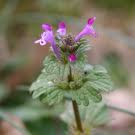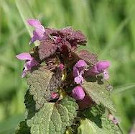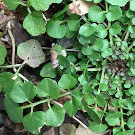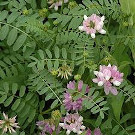9–12 minute read
Routine Care
mulching
Apply mulch after the ground has frozen but before the coldest temperatures arrive. Mulching before the ground has frozen delays plants from entering dormancy, increasing the likelihood of injury from a cold snap. Early mulch also can attract rodents looking for a warm over-wintering site.
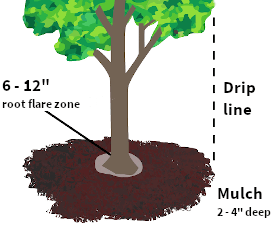
Find the best mulch for your situation
How to apply mulch
tidying
To reduce disease, remove and dispose of foliage (don’t compost) for the following:
- Roses — blackspot overwinters in fallen leaves
- Peonies — leaves & stems can harbor botrytis blight
- Bee balm, phlox, verbena bonariensis — leaves & stems can harbor powdery mildew
To reduce winter damage, leave frost-killed stems on:
- butterfly bushes
- hollow-stemmed species like salvias and hardy lantana
- marginally hardy species
watering
Water newly-installed or evergreen plants if weather conditions have been dry
- Choose warm days for watering, because plants cannot take up water if the ground is frozen.
- Water retains heat, so watering just before a cold snap can help plant roots survive bitter temperatures. </li>
houseplants
- Fertilize house plants as needed.
- Take leaf cuttings of your favorite house plants.
Propagating Houseplants
Plant propagation — leaf cuttings
Special tasks
bulbs
December is an excellent time to plant spring bulbs.
- Loosen the soil thoroughly, then plant at least as deep as recommended for the bulb size — usually 3 times as deep as the bulb diameter. Tulips and daffodils should be planted at least 5 to 8 inches deep.
- Fertilize lightly after planting with a balanced fertilizer. Bonemeal is not necessary .
- Consider deer damage when choosing what to plant:
- Frequently damaged: tulip, crocus, summer-blooming lilies
- Occasionally damaged: muscari, dahlia, daffodil, Leucojum aestivalis
- Rarely damaged: amaryllis, scilla, allium
Spring-Flowering Bulbs: Trials in North Carolina
Spring-Flowering Bulbs
For fun
Daffodils in Early Southern Gardens
Daffodils in Cemeteries (see p.7)
planting & Propagating
Because our soil usually stays warm enough for root growth all winter, planting now still gives roots time to repair and grow before the stress of summer heat. Our detailed instructions show how to prepare the soil and install plants, including special advice for planting trees.
- You can plant and transplant most woody plants and perennials. This is the optimal time for early-blooming perennials. Recovery is faster if plants are well-watered before you dig.
- Wait until spring growth begins to divide or transplant warm-season ornamental grasses. Their roots need warm soil to grow and their food reserves are low after fall bloom.
- Wait until spring to divide, plant or transplant hostas, tender perennials, fall-blooming perennials, and species that require a full growing season to develop a good root system such as butterfly bushes, tap-rooted plants like baptisias and hybrid purple coneflowers, and slow-growing, fleshy-rooted evergreens like magnolias and camellias. Plant, transplant or divide these in the spring once top growth begins or after the first flush of leaves has hardened (hostas, although it is best to transplant or divide these in September).
- Live Christmas trees should be kept indoors no more than 14 days before planting.
- Take hardwood cuttings of many landscape plants like crape myrtle, forsythia, holly, hydrangea, juniper, flowering quince, spirea, and weigela.
pruning
| Jan | Feb | Mar | Apr | May | Jun | Jul | Aug | ||||||||||
|---|---|---|---|---|---|---|---|---|---|---|---|---|---|---|---|---|---|
| TREES | |||||||||||||||||
| shade | |||||||||||||||||
| bleeder | small branches | ||||||||||||||||
| fruit | |||||||||||||||||
| SHRUBS | |||||||||||||||||
| summer-blooming | after bloom | ||||||||||||||||
| spring-blooming | after bloom | ||||||||||||||||
| broadleaf EG | dieback | ||||||||||||||||
| needle EG | |||||||||||||||||
| HERBACEOUS | |||||||||||||||||
| grasses | |||||||||||||||||
| flowers | pinch, deadhead | ||||||||||||||||
problems
Frosts & Freezes
Siting
Because cold air settles, there is usually more damage in low-lying areas. Plants on the east or south side of a building or wall are the most likely to be damaged. These areas warm up quickly after a frosty night and typically warm up faster in spring. Plants don’t know whether or not to stay dormant.
Damage
Frost damage will be less if there is some wind or cloud cover. Spraying plants with water before the sun strikes the leaves can reduce or eliminate damage from mild frosts.
Freeze damage usually does not occur until the air temperature is 30°F. A common form of damage is split bark on the southwest side of a thin-barked tree or shrub, caused by the sun’s rapid warming following an overnight freeze. Wrap trunks of young trees with cloth or paper for protection. Note that it often takes weeks/months before the damage is visible — azaleas may not show damage until the first hot spell.
Remove snow by gently sweeping branches upward to lift off snow without further stressing the limbs. Do not remove ice: frozen, laden limbs are very brittle and snap easily if bent the wrong way. Young branches often recover.
Protection
Protect roots of tender plants with a layer of mulch around the crown or a covering of conifer branches. For special plants, make a wire cage around the plant and fill it with leaves.
By trapping radiant heat from the ground, you can increase plant hardiness by more than 10 degrees.
- Covers should go all the way to the ground so that heat does not escape, but use stakes to prevent them from touching the plants.
- Burlap, bed sheets, blankets, and agri-fabric are preferred, but plastic buckets work as well. Plastic sheets and metal buckets are not recommended because they overheat too rapidly once the temperature rises.
- Be sure to remove the cover once the temperature is rising to prevent cooking the plant.
Pavement
Environmentally-friendly choices for traction on slippery surfaces include sand, cat litter, and ashes. Runoff from ice-melting salts can harm plants, while runoff from fertilizers can contaminate streams and groundwater.
pests
Beneficial insects share the same plants as insect pests. To protect beneficials, use low-toxicity pesticides when possible, spray only if needed and spray at dusk when pollinators are no longer active. Always read and follow label directions for safe pesticide application.
Click on a pest name in the pest calendar below to learn more.
| Jan | Feb | Mar | Apr | May | Jun | Jul | Aug | Sep | Oct | Nov | Dec |
|---|---|---|---|---|---|---|---|---|---|---|---|
| Emerald ash borer | |||||||||||
| tent caterpillar | |||||||||||
| black vine weevil | |||||||||||
| spider mites | |||||||||||
| scales, slugs | |||||||||||
| aphids, lace bugs | |||||||||||
| bagworm | pick bags | ||||||||||
| boxwood leaf miner | |||||||||||
| ironweed longhorn borer | |||||||||||
| flatid planthopper Japanese beetle CATERPILLARS: genista broom moth silvery checkerspot fall webworm | |||||||||||
| twospotted spider mite kudzu bug | |||||||||||
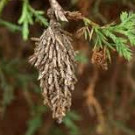 Bagworms can be controlled by hand-removing the bags before adults emerge in August–September (sprays cannot penetrated the bags) and during the fall, winter and spring, before the eggs hatch in May. Use a sharp knife/utility razor to cut the silk wrapped around the twig to prevent later girdling. Conifers like Conifers like arborvitae, cedar, juniper and pine sustain the most damage, but caterpillars also feed on many deciduous species such as willow, maple, locust, sycamore and elm. Scout buildings as well because often the bags are attached to siding.
Bagworms can be controlled by hand-removing the bags before adults emerge in August–September (sprays cannot penetrated the bags) and during the fall, winter and spring, before the eggs hatch in May. Use a sharp knife/utility razor to cut the silk wrapped around the twig to prevent later girdling. Conifers like Conifers like arborvitae, cedar, juniper and pine sustain the most damage, but caterpillars also feed on many deciduous species such as willow, maple, locust, sycamore and elm. Scout buildings as well because often the bags are attached to siding.
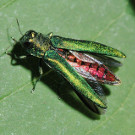 Emerald ash borers have been confirmed in Orange County. They attack all species of native ash as well as our native white fringetree. The top of the crown begins to thin and partially die (sprouting from the main stem of the tree may also occur), followed by death within 2–5 years. While the borers spread a few miles per year by flight, the main route of spread is from contaminated firewood. Interstate movement of EAB-host wood and wood products is prohibited for all of NC. However, movement within our state is not. Please be cautious when purchasing or accepting firewood, wood chips, etc. if you suspect that your trees are infected, please report the location and descriptions of potentially infested trees to 800-206-9333 or newpest@ncagr.gov.
Emerald ash borers have been confirmed in Orange County. They attack all species of native ash as well as our native white fringetree. The top of the crown begins to thin and partially die (sprouting from the main stem of the tree may also occur), followed by death within 2–5 years. While the borers spread a few miles per year by flight, the main route of spread is from contaminated firewood. Interstate movement of EAB-host wood and wood products is prohibited for all of NC. However, movement within our state is not. Please be cautious when purchasing or accepting firewood, wood chips, etc. if you suspect that your trees are infected, please report the location and descriptions of potentially infested trees to 800-206-9333 or newpest@ncagr.gov.
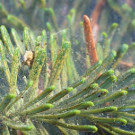 Cool season spider mites can attack many species. Southern red mites prefer broad-leafed evergreens, while spruce mites prefer conifers. They are active in the cooler months, usually during prolonged periods of high humidity. Hold a piece of white paper under a stem and vigorously shake the foliage. Ignore anything that moves quickly. Watch for specks smaller than a period to begin moving. Damage (interior browning of foliage) is not seen until early summer, when the mites are no longer present.
Cool season spider mites can attack many species. Southern red mites prefer broad-leafed evergreens, while spruce mites prefer conifers. They are active in the cooler months, usually during prolonged periods of high humidity. Hold a piece of white paper under a stem and vigorously shake the foliage. Ignore anything that moves quickly. Watch for specks smaller than a period to begin moving. Damage (interior browning of foliage) is not seen until early summer, when the mites are no longer present.
weeds
For common weeds not mentioned below, try this weed gallery. You can check for the toxicity, groundwater risk and persistance of many weed products in Toxicity of Lawn Chemicals.
- Watch for winter annual weeds. Hand-weed, apply preemergent in September or October when night temperatures are consistently 55–60° or apply a selective post-emergent when the temperature is above 40° all day long. Post-emergents are most effective when weeds are actively growing. While spring is best, you can also apply them in the fall while the weed is establishing its winter rosette.
- Treat perennial weeds such as wild onion and wild garlic with a broadleaf herbicide when temperatures are above 50°. Be careful to distinguish mock strawberry, an invasive alien, from our native barren strawberry.
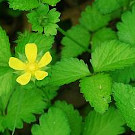 weed mock strawberry
weed mock strawberry wildflower barren strawberry
wildflower barren strawberry - Control invasive vines and unwanted tree saplings.
- For saplings that are too large to pull, cut off close to the ground and clear away debris. Immediately paint or spray the exterior and the cut surface with a 15–25% solution of glyphosate --- waiting more than 5 minutes can prevent absorption. For a larger stump, only the outer two-thirds is live wood and needs treatment.
- English ivy control differs by season. In fall, hand-pull vines and re-visit periodically to remove any residual new growth. In spring, hand-pull or use herbicide.



